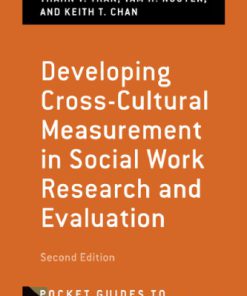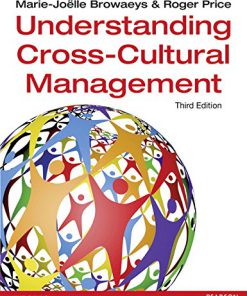Cross Cultural Psychology 2nd Edition by Kenneth Dwight Keith 1119438441 9781119438441
$50.00 Original price was: $50.00.$25.00Current price is: $25.00.
Cross Cultural Psychology 2nd Edition by Kenneth Dwight Keith – Ebook PDF Instant Download/DeliveryISBN: 1119438441, 9781119438441
Full download Cross Cultural Psychology 2nd Edition after payment.

Product details:
ISBN-10 : 1119438441
ISBN-13 : 9781119438441
Author: Kenneth Dwight Keith
This book addresses key areas of psychology, placing them in cultural perspective via a comprehensive overview of current work integrating culture across the major subfields of psychological science. Chapters explore the relation of culture to psychological phenomena, starting with introductory and research foundations, and moving to clinical and social principles and applications. It covers the subfields that are of most importance to undergraduates and beginning graduates, such as consciousness, development, cognition, intelligence, personality, research methods, statistics, gender, personality, health, and well-being.
Cross-Cultural Psychology: Contemporary Themes and Perspectives, 2nd Edition is richly documented with research findings and examples from many cultures, illuminating the strengths and limitations of North American psychology, while also highlighting the diversity and vitality of this fascinating field. The book offers many new chapters, in addition to fully updated ones from the previous edition. Starting with basic concepts in the subject, the book offers chapters covering ethnocentrism, diversity, evolutionary psychology, and development across cultures. It also examines education, dreams, language and communication issues, sex roles, happiness, attractiveness, and more.
Cross Cultural Psychology 2nd table of contents:
Part I: Basic Concepts
1 Psychology and Culture
Culture
Why Cross‐Cultural Psychology?
Teaching about Culture: How Have Our Textbooks Changed?
Cross‐Cultural Psychology: What It Is and Where It Has Come From
Some Basic Principles
Conclusion
References
2 Ethnocentrism
What Are the Characteristics of Ethnocentrism?
How Does Ethnocentrism Develop?
Can We Reduce Our Ethnocentrism?
Conclusion
References
3 Cross‐Cultural Competence
Conceptualizing Cross‐Cultural Competence
Cultural Immersion and Cross‐Cultural Competence
Theoretical and Methodological Implications
Measuring Cross‐Cultural Competence
Implications for the Development of Cross‐Cultural Expertise
Conclusion
References
Part II: Culture, Psychological Science, and Research Methods
4 Methodological and Conceptual Issues in Cross‐Cultural Research
Historical Elements
Universals and Measurements Across Cultures
Issues in Culturally Relevant Research: Individualism and Collectivism
Culture and Its Relation to Thought and Language
Methodological Issues
Stimulus and Measurement Materials
Ethics
Conclusion
References
5 The Inextricable Link Between Culture and Statistics
Statistics Is Built on Variability
Understanding Statistics Through Culture, and Understanding Culture Through Statistics
Conclusion
References
6 Infusing Diversity into Research Methods = Good Science
Validity
Methodological Design Concerns
Research Ethics
Conclusion
References
7 Evolution and Cross‐Cultural Psychology
Natural Selection in Humans
Cross‐Cultural Evidence for Natural Selection in Humans
Culture as Adaptation
Gene‐Culture Co‐Evolution
Evolved Cross‐Cultural Variation and Similarities
Conclusion
References
Part III: Development
8 Child Development Across Cultures
Cognitive Development: Piaget’s Stages
Modern Approaches to Cognitive Development
Temperament
Attachment
Conclusion
References
9 Adolescent Development in a Cross‐Cultural Perspective
Biological and Physical Development
Cognitive Development and Education
Socio‐Emotional Development
Adolescents Experiencing Vulnerable or Difficult Circumstances
Conclusion
References
10 Cultural Variations in Perceptions of Aging
Physical Declines
Social Roles
Intergenerational Relationships and Living Arrangements
Death Anxiety: The Fear of Death
Conclusion
References
Part IV: Cognition
11 Culture and Cognition
Culture, Cognition, and Development: Some Definitional Considerations
Culture and Cognitive Development: Universal Processes
Conclusion
References
12 Conceptions and Approaches to Education Across Cultures
Conceptualizing Cross‐Cultural Education
Cross‐Cultural Education in K‐12 Education in the United States
Promoting Cross‐Cultural Understanding in K‐12 Education
Cross‐Cultural Education in Higher Education in the United States
Moving Forward: Challenges and Possibilities
References
Websites
13 Cross‐Cultural Differences in Visual Perception of Color, Illusions, Depth, and Pictures
Color Perception
Picture Perception: Perceiving Depth in Pictures
Picture Perception: Context and Wholeness
Conclusion
References
14 International Developments Influencing the Field of Intellectual and Developmental Disabilities
Better Understanding of Disability‐Related Constructs
An Integrative Approach to Disability
Service Delivery System Transformation
Conclusion
References
Part V: Consciousness
15 Culture and Dreams
Culture and Dreams: What Are They?
Cultural Templates Shape Dream Imagery, Interpretation, and Expression
Dreams Confirm, Extend, and Modify Cultural Models
Dreams Diffuse and Diversify Culture
Dreams Depict Cultural Updating in the Mind
Evolutionary Origins of Human Sleep Patterns and the Capacity for Culture
Conclusion: Culture and Dreams Are Mutually Instantiating
References
16 Consciousness and Culture
Consciousness
Culture and Consciousness
Studying Altered States
References
Part VI: Language and Communication
17 Language and Culture
Do Languages Have Universal Properties?
Language, Culture, and Thought
Assumptions and Misunderstandings
Conclusion
References
18 Crossing Boundaries
Communication, Culture, and Cross‐Cultural Communication
Challenges in Cross‐Cultural Communication Research
The Intersection of Communication, Culture, and Ethnic Identity
Implications in Cross‐Cultural Communication
The Intersection and Boundaries of Identity: What This All Means
Wrapping Up
References
Part VII: Gender and Sex Roles
19 Women Across Cultures
Physical Bodies and Appearance
Work and Pay
Violence Against Women
Power and Leadership
Conclusion
References
20 Stability or Change? A Cross‐Cultural Look at Attitudes Toward Sexual and Gender Identity Minorities
Terminology
Cultural Influences on Sexual and Gender Identity Minorities
Cross‐Cultural Attitudes Toward Sexual Minorities
Predictors of Attitudes Toward Homosexuality
Cross‐Cultural Attitudes Toward Transgender People
Experience of Discrimination among LGBT Populations
Conclusion
References
Part VIII: Health, Disorders, and Treatment
21 Cultural Influences on Health
What Is Culture?
Cultural Variations in Health: Health Disparities
Cultural Variations in Approaches to Health
But Does It Work?
Culture and Mental Health
Conclusion
References
22 Perspectives of Psychopathology Across Cultures and Among Indigenous Societies
Approaches to Cultural‐Clinical Psychology
Culture, Psychopathology, and the DSM
Indigenous Psychologies
Looking Forward
References
23 Culture and Psychotherapy
Psychotherapy: Universal Functions and Culture‐Specific Contents
Globalization, Diversity, and Dissemination of Evidence‐Based Practices
Practitioners’ Knowledge of Empirically‐Supported Therapies
Cultural Competencies in Psychotherapy
Cultural Adaptation of Empirically‐Supported Psychotherapy
Culturally‐Responsive Cognitive Behavior Therapy: Asking the Right Questions to Expand the Application
Beyond Specific Therapies: Therapy as Negotiation in Cross‐Cultural Context
Conclusion
References
Part IX: Emotion and Well‐Being
24 Culture, Emotion, and Expression
Basic Emotions
Previous Studies Examining the Facial Expressions of Emotion in Blind Individuals
Evidence Concerning the Source of Universal Facial Expressions of Emotion
Conclusion
References
25 Wellbeing Across Cultures
Achieving Wellbeing
The Character of Subjective Wellbeing
Measuring Subjective Wellbeing
Cross‐Cultural Differences in SWB
Conclusion
Acknowledgments
References
26 Happiness Around the World
Ratings of Happiness Around the World
Why Should Governments Care About Happiness?
Conclusion
References
Part X: Social Psychology
27 Social Influence
Source Factors in Social Influence
Message Factors in Social Influence
Focus on the Group
Social Influence Processes
Resistance to Social Influence
Conclusion
References
28 Cross‐Cultural Differences and Similarities in Attribution
Attributions of Others’ Behavior: The Correspondence Bias
Attributions for Our Behavior: The Self‐Serving Bias
Applications of the Attribution Biases across Cultures
Future Directions and Conclusion
References
29 The Importance of Attractiveness Across Cultures
Physical Attractiveness
The Benefits of Beauty
A Cultural Perspective on Attraction
Our Research
Conclusion
References
30 Multicultural Identity Development
Theories of Identity Formation
Cultural Identity
Individualism and Collectivism
Sources of Multicultural Identity
Forming a Multicultural Identity: Gains and Losses
Life in a Multicultural World
Conclusion
References
31 Cross‐Cultural Organizational Psychology
Why an African Perspective?
Organizational Systems in Africa
Leadership Styles in Africa
Staff Commitment and Motivation in Africa
Toward a Conceptual Model
Indigenous Psychology and Interethnic Level of Analysis
The Changing Global Landscape
Conclusion
References
Part XI: Personality
32 Culture and Theories of Personality
Western Theories of Personality
Two Eastern Approaches to Understanding Personality
Conclusion
References
33 The Five‐Factor Model
Introduction
A Brief History of FFM and FFT Development
The Five‐Factor Model
The Five‐Factor Theory
FFM Personality Traits Across Cultures
Conclusion
References
Part XII: Concluding Thoughts
34 Culture and Psychology
World Conflict: Can Psychology Help?
Environment/Resource Distribution
Where Have We Been?
Teaching Cross‐Cultural Psychology
Conclusion
People also search for Cross Cultural Psychology 2nd:
journal of cross cultural psychology
goals of cross cultural psychology
history of cross cultural psychology
international association for cross cultural psychology
social and cross cultural psychology
Tags: Cross Cultural, Psychology, Kenneth Dwight Keith,
You may also like…
Politics & Philosophy - Social Sciences
Cultural Anthropology Fieldwork Journal Second Edition Kenneth J. Guest
Politics & Philosophy - Government & Politics
Politics & Philosophy
History & Research
Politics & Philosophy - Social Sciences
Developing Cross-Cultural Measurement In Social Work Research And Evaluation Keith T. Chan
Relationships & Lifestyle - Psychological Self-Help
Psychology of Personality Jean M. Twenge & W. Keith Campbell.
Politics & Philosophy
Semantics and Psychology of Spirituality a Cross Cultural Analysis Hood
Psychology
Business & Economics - Human Resources












